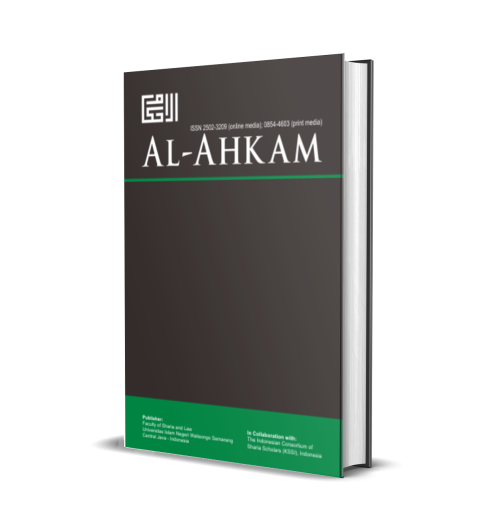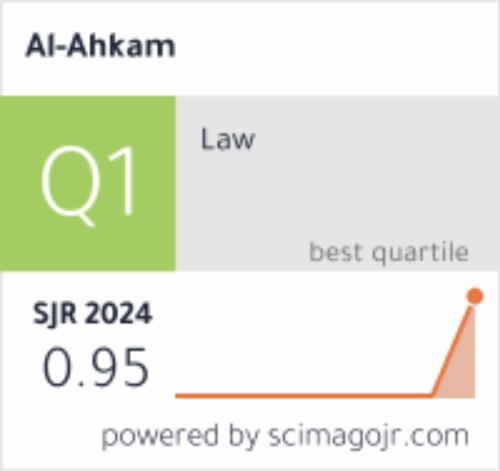Uṣūl al-Fiqh Literacy for the Local Community: A Study on Shaykh Mukhtar Ambai’s Manuscript
DOI:
https://doi.org/10.21580/ahkam.2023.33.2.17045Keywords:
literacy, manuscript, Mukhtar Ambai, Risālah Marḍiyah, uṣūl al-fiqhAbstract
Ancient manuscripts with uṣūl al-fiqh themes remain rare amidst the increasing efforts to inventory, categorize, and digitize old manuscripts in present-day Indonesia. Nevertheless, literacy initiatives related to uṣūl al-fiqh can still be identified within manuscripts exploring different subjects. This study aims to elucidate how a non-uṣūl al-fiqh-themed manuscript can encompass uṣūl al-fiqh insights intended for a local community. Employing a documentary approach, it relies on primary data from Risālah Marḍiyah by Shaykh Mukhtar Ambai Kerinci. Subsequently, content analysis utilizing a qualitative model captures messages, meanings, linguistic styles, and symbolic interactions. The study reveals that uṣūl al-fiqh’s topics in the manuscript are conveyed using five methods: illustration and exemplification, the statement-argument-example pattern, comparison, argumentative conjunction, if-then pattern, and citation models. The argument posits that scholarly uṣūl al-fiqh literacy efforts in the past need not be solely assessed by the quantity of ancient uṣūl al-fiqh-themed manuscripts; instead, they can be discerned in other manuscripts employing more operationally creative, contextual, and easily comprehensible delivery methods, serving a broader audience.Downloads
References
Ahmad, Jafar, and Nuzul Iskandar. “The Acculturation Crisis and Religious Commodification in the Customary Conflict of Rencong Telang Kerinci.” Jurnal Penelitian 19, no. 1 (2022): 11–22. https://doi.org/10.28918/jupe.v19i1.5114.
Akhimuddin, Yusri. “Pemetaan Naskah-Naskah Keagamaan di Padang Pariaman.” Batusangkar, 2007.
al-Asnawī, ’Abdurraḥīm ibn al-Ḥasan ibn ’Alī. Nihāyah al-Sūl Sharḥ Minhaj al-Wuṣūl. Beirut: Dār al-Kutub al-’Ilmiyah, 1999.
Ali, Yunasril, Ismail Thaliby, Sonafist Sonafist, Hasadi Hamid, Norewan Norewan, Hermalis Hermalis, Eka Putra, and Syamsi Syamsi. Adat Basendi Syara’ Sebagai Fondasi Membangun Masyarakat Madani di Kerinci. Edited by Mhd. Rasidin. 1st ed. Sungai Penuh: STAIN Kerinci Press, 2005.
Alimin, Alimin. Sastra Incung Kerinci. Sungai Penuh: Dinas Kebudayaan dan Pariwisata Kota Sungai Penuh, 2003.
Ambai, Mukhtar. Risālah Marḍiyah fī Bayān al-Rawātib al-Qabliyah wa al-Ba’diyah wa Ghayrihā min al-Sunan. Bukittinggi: Kahamy, 1960.
Barton, David, and Mary Hamilton. “Literacy Practices.” In Situated Literacies: Reading and Writing in Context, edited by David Barton, Mary Hamilton, and Roz Ivanic, 222. London and New York: Routledge, 2000.
Bonate, Liazzat J. K. “Islam and Literacy in Northern Mozambique: Historical Records on the Secular Uses of the Arabic Script.” Islamic Africa 7, no. 1 (2016): 60–80. https://doi.org/10.1163/21540993-00701007.
Bonatz, Dominik, John David Neidel, and Mai Lin Tjoa-Bonatz. “The Megalithic Complex of Highland Jambi: An Archaeological Perspective.” Bijdragen Tot de Taal-, Land- En Volkenkunde 162, no. 4 (2006): 490–522. https://doi.org/10.1163/22134379-90003664.
Bungin, Burhan. Analisis Data Penelitian Kualitatif. Jakarta: Rajawali Press, 2015.
Bustamam, Ridwan. “Eksplorasi dan Digitalisasi Manuskrip Keagamaan: Pengalaman di Minangkabau.” Jurnal Lektur Keagamaan 15, no. 2 (2017): 446–69. https://doi.org/10.31291/jlk.v15i2.532.
Creswell, John W. Research Design: Pendekatan Metode Kualitatif, Kuantitatif, dan Campuran. 4th ed. Yogyakarta: Pustaka Pelajar, 2016.
Dung, Phan Minh, and Phan Minh Thang. “Closure and Consistency In Logic-Associated Argumentation.” Journal of Artificial Intelligence Research 49, no. January (2014): 79–109. https://doi.org/10.1613/jair.4107.
Gusmian, Islah. “Manuskrip Keagamaan di Masjid Popongan: Kajian Kodikologi dan Pemetaan Isi.” Diinika: Academic Journal of Islamic Studies 4, no. 2 (2019): 249–74. https://doi.org/10.22515/dinika.v4i2.2059.
al-Ghazzālī, Abū Ḥāmid Muḥammad ibn Muḥammad. Al-Mustaṣfā min ’Ilm al-Uṣūl. Beirut: Dār Iḥyā ’al-Turāth al-’Ᾱrabi, n.d.
Habieb, Sa’di Abu. Ensiklopedi Ijmak: Persepakatan Ulama dalam Hukum Islam. Edited by Sahal Mahfudh and Bisri Mustofa. Jakarta: Pustaka Firdaus, 1987.
Hallaq, Wael B. An Introduction to Islamic Law. 1st ed. UK: Cambridge University Press, 2009.
Hamid, Wardiah, Hamsiati Hamsiati, Idham Idham, and Wan Shahrazad Wan Sulaiman. “Religious Moderation Based on Ancient Manuscript in Maros District.” Jurnal SMART (Studi Masyarakat, Religi, dan Tradisi) 9, no. 1 (2023): 1–13. https://doi.org/10.18784/smart.v9i1.1862.
Hamzani, Yusri. “Naskah Perukunan Batu Cangku: Peran Dakwah Tuan Guru terhadap Perkembangan Budaya Literasi Masyarakat.” Komunike 10, no. 2 (2018): 171–92. https://doi.org/10.20414/jurkom.v10i2.678.
Hidayat, Ahmad Taufik, Apria Putra, and Chairllah Ahmad. Katalog Surau II: Panduan Koleksi Naskah Pusaka Syekh Burhanuddin Ulakan Surau Pondok Tanjung Medan. Edited by Benny Benny. 1st ed. Padang: Imam Bonjol Press, 2014.
Iskandar, Nuzul. “Empat Risalah Syekh Mukhtar Ambai: Pribumisasi Fikih Melalui Aksara Arab-Melayu di Kerinci.” Asy-Syakhshiyyah: Jurnal Hukum Keluarga Islam dan Kemanusiaan 4, no. 2 (2022): 101–24. https://doi.org/10.30863/as-hki.v4i2.2845.
Iskandar, Nuzul, Arzam Arzam, and Jafar Ahmad. “Negosiasi Otoritas Fikih: Relasi Perti Kultural dan Organisasi Keagamaan Arus Utama di Kerinci.” Ijtihad 37, no. 2 (2021): 1–14. https://journals.fasya.uinib.org/index.php/ijtihad/article/view/104.
Iskandar, Nuzul, Indah Herningrum, and Susi Susanti. “Islamic and Cultural Negotiations in Endogamous Marriage in Kerinci.” Jurnal Hukum Islam 20, no. 1 (2022): 49–72. https://doi.org/10.28918/jhi.v20i1.6515.
Iswanto, Agus. “Kecenderungan Kajian Manuskrip Keislaman di UIN Syarif Hidayatullah Jakarta.” Al-Qalam 21, no. 1 (2016): 107–16. https://doi.org/10.31969/alq.v21i1.202.
Iswanto, Agus. “Praktik Literasi Agama Pada Masyarakat Indonesia Tempo Dulu: Tinjauan Awal atas Naskah-Naskah Cirebon.” Manuskripta 8, no. 2 (2018): 43–65. https://doi.org/10.33656/manuskripta.v8i2.114.
Khalaf, Abdul Wahab. ’Ilmu Uṣūl al-Fiqh. 8th ed. Maktabah al-Da’wah al-Islāmiyah Shabāb al-Azhār, 1947. https://ia902601.us.archive.org/4/items/osol_fikh_khallaf/osol_fikh_khallaf.pdf.
Kozok, Uli. Kitab Undang-Undang Tanjung Tanah: Naskah Melayu Yang Tertua. Jakarta: Yayasan Obor, 2006.
Luthfi, Khabibi Muhammad. “Kontekstualisasi Filologi dalam Teks-Teks Islam Nusantara.” Ibda`: Jurnal Kajian Islam dan Budaya 14, no. 1 (2016): 114–28. https://doi.org/10.24090/ibda.v14i1.523.
Meirison, Meirison, Ayu Rustiana, Fikri Muhtada, M.Gery Coslo, and Muhammad Abdul Aziz. “An Aplication Study on Taklifi Law: Fiqh Schools (Madhab) Perspective.” Hunafa: Jurnal Studia Islamika 18, no. 2 (2021): 195–214. https://doi.org/10.24239/jsi.v18i2.619.195-214.
Nakassis, Constantine V. “Citation and Citationality.” Signs and Society 1, no. 1 (2013): 51–77. https://doi.org/10.1086/670165.
Nurzakiyah, Cucu. “Literasi Agama Sebagai Alternatif Pendidikan Moral.” Jurnal Penelitian Agama 19, no. 2 (2018): 20–29. https://doi.org/10.24090/jpa.v19i2.2018.pp20-29.
Oliveira, Alandeom W., and Adam O. Brown. “Exemplification in Science Instruction: Teaching and Learning through Examples.” Journal of Research in Science Teaching 53, no. 5 (2016): 737–67. https://doi.org/10.1002/tea.21319.
Parsons, Kate. “Religious Literacy in Policy and Practice.” Social Work Education 35, no. 5 (2016): 613–14. https://doi.org/10.1080/02615479.2016.1144364.
Purcell-Gates, Victoria, Kristen H. Perry, and Adriana Briseno. “Analyzing Literacy Practice: Grounded Theory to Model.” Research in the Teaching of English 45, no. 4 (2011): 439–58.
Purkon, Arip. “Historical Dynamics of Islamic Law Methodology (Ushul Fiqh).” Mizan: Journal of Islamic Law 2, no. 2 (2018): 117–26. https://doi.org/10.32507/mizan.v2i2.295.
Putra, Adi, and Rima Melati. “Perkembangan Aksara Incung dalam Memperkenalkan Identitas Budaya Melalui Seni Batik.” Krinok: Jurnal Pendidikan Sejarah dan Sejarah 1, no. 2 (2022): 83–88. https://doi.org/10.22437/krinok.v1i2.19945.
Rackley, Eric D. “Motivation for Religious Literacy Practices of Religious Youth: Examining the Practices of Latter-Day Saint and Methodist Youth in One Community [Ph.D Dissertattion].” The University of Michigan, 2010.
Rasidin, Mhd., and Oga Satria. “Tradisi Tulis Ulama Kerinci: Manuskrip Islam Peninggalan K.H. Muhammad Burkan Saleh (1912-2010).” Jurnal Lektur Keagamaan 18, no. 2 (2020): 463–88. https://doi.org/10.31291/jlk.v18i2.860.
Rosowsky, Andrey. “Faith Literacies.” In The Routledge Handbook of Literacy Studies, edited by Jennifer Rowsell and Kate Pahl, 700. London: Routledge, 2020.
al-Shahruzūrī, ’Uthmān ibn ’Abdurraḥmān. ’Ulūm al-Ḥadīth. Damaskus: Dār al-Fikr, 2009.
Sakdiah, Halimatus. “Mathba’ah Islamiah di Minangkabau: Sejarah Sebuah Penerbit Islam Melintasi Tiga Zaman (1924-1972).” Islam Transformatif: Journal of Islamic Studies 4, no. 2 (2020): 176–88. https://doi.org/10.30983/it.v4i2.3442.
al-Subkī, Tāj al-Dīn ’Abd al-Wahhāb. Jam’ al-Jawāmi’ fi Uṣūl al-Fiqh. Beirut: Dār al-Kutub al-’Ilmiyah, 2003.
Sudiar, Nining, Rosman H, and Hadira Latiar. “Peta Naskah Kuno Kabupaten Kampar Provinsi Riau.” Manuskripta 8, no. 2 (2018): 169–82. https://doi.org/10.33656/manuskripta.v8i2.120.
Sunarti, Sastri. “Suara-Suara Islam dalam Surat Kabar dan Majalah Terbitan Awal Abad 20 di Minangkabau.” Buletin Al-Turas 21, no. 2 (2020): 229–42. https://doi.org/10.15408/bat.v21i2.3839.
Sunliyensar, Hafiful Hadi. Padi dalam Kehidupan Orang Kerinci. Jakarta: Perpusnas Press, 2022.
Sunliyensar, Hafiful Hadi. Tanah, Kuasa, dan Niaga: Dinamika Relasi Antara Orang Kerinci dan Kerajaan-Kerajaan Islam di Sekitarnya dari Abad XVII hingga Abad XIX. Jakarta: Perpusnas Press, 2019.
Syarifuddin, Amir. Ushul Fiqh 1. 5th ed. Jakarta: Kencana, 2011.
Voorhoeve, Petrus. Tambo Kerinci. Edited by Uli Kozok. Honolulu, 2006.
Watson, C. W. “Kinship, Property and Inheritance in Kerinci, Central Sumatra.” Centre for Social Anthropology and Computing, 1992.
Watson, C. W. “Local Lineages in Kerinci, Sumatra.” Indonesia and the Malay World 48, no. 142 (2020): 379–96. https://doi.org/10.1080/13639811.2020.1801030.
Widyastuti, Wiwien. “Pengenalan Aksara Pallawa dengan Model Hidden Markov.” In Prosiding Seminar Nasional Rekayasa Teknologi Industri dan Informasi (RETII) Ke-17 Tahun 2022, edited by Daru Sugati, Sugiarto Kadiman, Rizqi Prastowo, Al Hussein Flowers Rizqi, Didit Setyo Pamuji, and Angger Bagus Prasetyo, 126–31. Yogyakarta, 2022.
Ya’qub, Ali Musthafa. Al-Thuruq Al-Ṣaḥīḥah Fī Fahm Al-Sunnah Al-Nubuwwah. Edited by Ahmad Abidi Hasbullah. 2nd ed. Jakarta: Makktabah Dar al-Sunnah, 2016.
Yang, Wenxing, and Ying Sun. The Use of Cohesive Devices in Argumentative Writing by Chinese EFL Learners at Different Proficiency Levels. Linguistics and Education. Vol. 23. Elsevier Inc., 2012. https://doi.org/10.1016/j.linged.2011.09.004.
Yusram, Muhammad. “Hukum Meriwayatkan dan Mengamalkan Hadis Daif untuk Fadhail al-A’mal.” Nukhbatul ’Ulum 3, no. 1 (2017): 221–36. https://doi.org/10.36701/nukhbah.v3i1.17.
Zakaria, Iskandar, and Deki Saputra. Khazanah Aksara Incung. Sungai Penuh: Dinas Kebudayaan dan Pariwisata Kota Sungai Penuh, 2017.
Zein, Satria Efendi M. Ushul Fiqh. 7th ed. Jakarta: Kencana, 2005.
al-Zuhaylī, Wahbah. Uṣūl al-Fiqh al-Islāmī. Suriah: Dar al-Fikr, 1986.
Downloads
Published
How to Cite
Issue
Section
License
By submitting an article to the journal, the author(s) agree to transfer the published article's copyright to the journal, which will act as the publisher. This means the journal will have the right to publish the article in various forms, including reprints. The journal will maintain the publishing rights to the published articles.
In line with the license, authors and third parties (readers, researchers, and others) are allowed to share and adapt the material. In addition, the material must be given appropriate credit, provided with a link to the license, and indicated if changes were made. If authors remix, transform or build upon the material, authors must distribute their contributions under the same license as the original.



